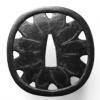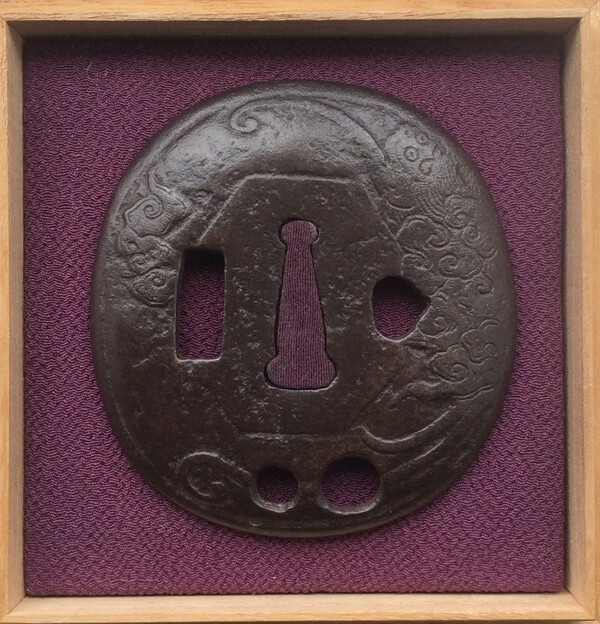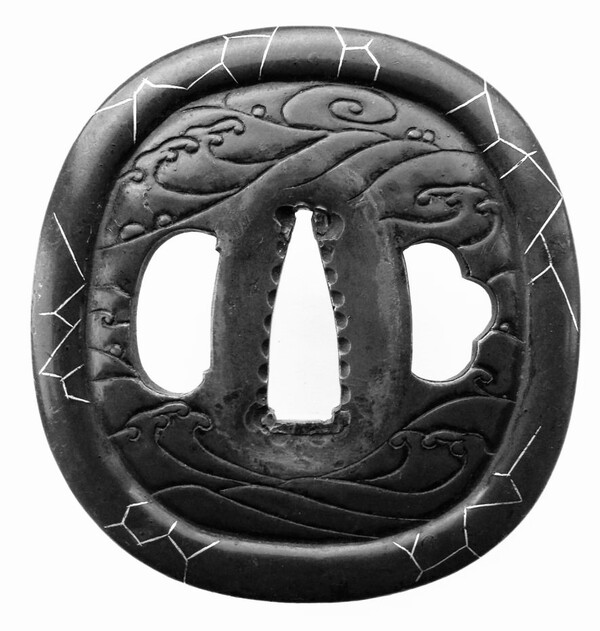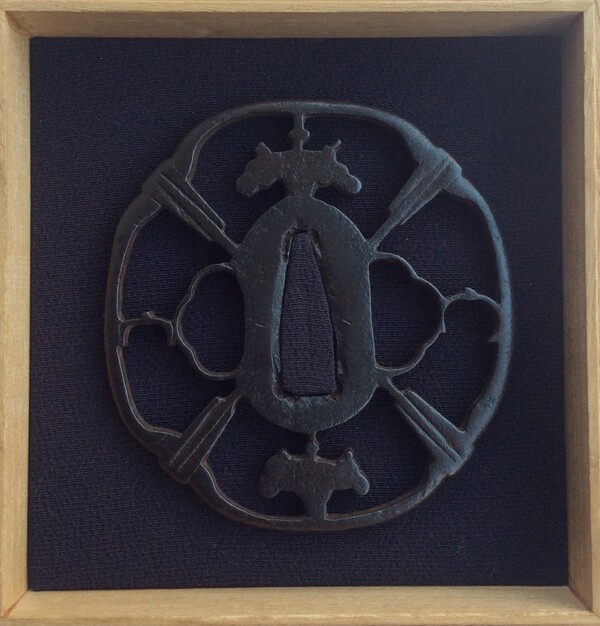-
Posts
250 -
Joined
-
Last visited
-
Days Won
1
Content Type
Profiles
Forums
Events
Store
Downloads
Gallery
Everything posted by Michael 101
-
Lovely example Dirk, so what with your 1st master, Currans 2nd master I better add a 3rd master Jingo. happy Christmas to all. michael
-
Hi Pete, the tsuba at the top of the thread but I understand your question but the other ( Torigoye example ) at least has a typical Kanshiro dote mimi. Where as the first example I feel has too many points against it being Kanshiro so perhaps ko kinko is more likely. i dont like the hitsu ana shape on either and prefer more Higo influence like the attached example by the first kanshiro. kindest regards michael
-
I understand the cast comment but think unlikely, perhaps more likely to have suffered rusting at some point and treated to restore the colour a long time ago - but not really possible to be certain from pictures alone. The square akasaka also so signs of similar treatment. Both are very good powerful Akasaka designs. kindest regards michael
-
Very nice tsuba. Although there are similarities between this tsuba and the 2nd Kanshiro tsuba, especially in the carving of the waves and the decoration of the mimi, I dont think that the tsuba in question was made by Kanshiro. It is well known that Ko Kinko workers were of great influence to the Higo schools and that is what I believe you have here. Basically its overall shape and the carving of the mimi would be very unlikely for Kanshiro, also the hitsu ana shape and the seppa dai area again rarely seen in kanshiro works so when taken together I think ko kinko is far more likely. the 2nd kanshiro was apprenticed at a young age to the Goto school and this had an influence in the carving of his waves, so they differ greatly from the first master but have closer affinity with the ko kinko and goto form which makes it harder to distinguish between the schools in cases like this one. If it were mine I would certainly consider a gentle clean or restoration as I think it could easily look quite magnificent afterwards and worth the investment. Great find. Kindest regards michael
-
Hi Mikolaj, i agree with the opinion of tosa mychin for the irregular shaped pine tree, looks a very nice example. the Kanshiro is very nice indeed, especially with its provenance. Beautiful iron by the look of your pictures. the other is slightly harder from pictures alone it is always helpful to include full measurements including thickness at the centre and at the mimi to help judgement. My thought on this one is Hayashi however the inlay work is questionable in terms of quality versus good the carving of the tsuba so possibly added later. Or it could be a late higo copy ( these tend to be slightly thinner hence my suggestion to include measurements where possible ) but the iron quality and colour looks suggests earlier work. kind regards michael
-
Hi Roger, when you say ugly hitsu ana excavations- did you actually mean the marks around the nakago ana ? if so then I dont think these spoil this tsuba - its just a sign that the tsuba has been adjusted and mounted to a sword and not spent its life sitting in a box - so in many ways adds to the history of the tsuba. this style of inlay was very popular in the 19th century and look to be the same age as the tsuba - although it would be hard to be certain if it were original or added slightly later, although my money would be on the former. Kindest regards Michael
-
Hello Peter, This design ( tomi matsu ) is thought to have originated with the 1st Kanshiro master who’s version was carved in a more detailed style also using kebori engraving - and then adapted by Matachichi ( 1st Hayashi master ) into the more stylised version on which your tsuba is based on. The design was used throughout the Hayashi and Kamiyoshi schools ( for example see attached version by Kamiyoshi Fukanobu) and also many others in the late Edo period. The slightly crude carving on the tsuba you have shown suggests to me another hand maybe a late Edo copy by Tsuboi or amateur samurai work. The iron looks old and I dont think its modern. The crudeness is around the kogai hitsuana and also the inner edges to the sukashi and soft lines to the surface which may be attempted artificial ageing or slight damage it’s difficult too judge. Kindest regards Michael
-
Hi Luis, To help get quality feedback its very important that you add dimensions in mm giving height, width and thickness at the seppa dai and also the mimi. You will also need to add pictures showing the front and reverse straight on as seppa dai shape is important and is not possible to judge from your good bat angled pictures. Hints at being a goid tsuba BTW. Kindest regards Michael
-
Not fake just late Edo production, possibly cast. It was a popular style to copy in this period. Kindest regards Michael
-
Hello Michael, Well I can say that the tsuba is made by Hirada Kunishige who was ( from memory) a Hizen based artist who was very influenced by his contact with the west. Hence the use of European lettering in its design. Look him up for more information but his work is very collectable indeed. Good find Kindest regards Michael
-
The signature to the reverse side is very commonly seen on tsuba for example most Kinai were signed to the reverse. Reasons given vary, out of respect, special commision etc so I wouldn’t let this point cary any weight over judgement of this work. Without seeing it in hand I can only echo earlier comments but part cast ( seppa dai area is poorly shaped ) and hand finished such as the carving seen to the reverse is a real possibility. I wouldnt have thought it from the Edo period. Has anyone translated the signature, which seems an obvious clue ? Kindest regards Michael
-

Which Of Your Tsubas Best Embodies The Wabi-Sabi Aesthetic?
Michael 101 replied to lotus's topic in Tosogu
Love Petes kozuka, so much like a classic ink picture of the period. Its just oozes atmosphere and the moon to the reverse just perfect. Great find. Kindest regards Michael -

Which Of Your Tsubas Best Embodies The Wabi-Sabi Aesthetic?
Michael 101 replied to lotus's topic in Tosogu
These are my personal candidates. A first master Kanshiro Iron sukashi and a first master Shimizu Jinbei in soft metal. The Kanshiro is unsymmetrical and carved with a masters confidence and freedom. The Shimizu has a weathered appearance with the soft metal worked in a very similar way to his iron works. The colour and patina is perfect. If you look closely you will see many cracks and faults from the time it was produced. Each example is in my view equally, but beautifully, imperfect and have the atmosphere and estetics of early Edo tea culture Japan. Hope you like them. Kindest regards Michael -
I must admit that cant really see anything higo about this tsuba and agree with above comment ref Akasaka especially considering its thickness in comparison with its smaller size. Nice looking tsuba all the same. Kindest regards Michael
-
Yagyu did get quite large but your right not to this tsuba proportions. It was the nakago ana shape that influenced my initial thoughts in that direction. I think Owari was the better call - especially the circle within the circle element of the design which is frequently seen - flick through the Sasano silver book for at least 4 examples. I also considered Akasaka but with that mimi I very much doubt so - but all these schools ( Akasaka, Yagyu and Owari ) share influences. I still think early Edo for date. Kindest regards Michael
-
Hi Florian, What a superb tsuba. When I first looked I wanted to say Yagyu but Im not sure if this is one of their designs ( I have a book somewhere and will follow this thought up ). If Yagyu then it would be a rare large size for the school. Could you confirm its thickness at the centre and at the edge as this detail could be useful to others in assistance. Given the large proportions and iron quality my guess would Owari of the early 1600,s Thanks for posting All the best Michael
-
Richard - so where do we order these then ? Steven, its an easy mistake to make just from pictures if you have not handled many Norisuke tsuba. I have often seen surface texture the very same as yours on their tsuba, Infact if you look on Tetsugendo facebook page there is a Norisuke pictured with the very same texture - and those guys as professional dealers no their stuff. Just seems to have been a peculiarity of their iron. In an ironic way I think both Norisukes ( father and son ) would be rather pleased if it were a copy as that is mainly how they made their living and probably see it as a complement. Kindest regards Michael
-
Great find Steven, and in the most unlikely of places. Looks 100% geniune to my eyes, I have seen this iron finish on may of his works. I have seen VW car badges used as pendants ( not by me I hasen to add ) but never tsuba, you might have started a new fashion craze here !! Kindest regards Michael
-
Hi Barrie, I certainly think its enspired by Hayashi style thats for sure but I the kogai hitsu shape is not at all what I would expect from Hayashi amoungst other points already raised. Its a very nice large size which would suggest early Hayashi period but the work suggests not - so later work styled on Hayashi may be the closest we can get for now. The late Edo period was very much a melting pot for styles and we start to see the traditional strictness of the school designs blend together making it sometimes impossible to classify further. Lets hope another member can add more guidance on this one. Many thanks Michael
-
Hi Barrie, I suspect you have not had any replies as I guess others like myself, are still scratching their heads on this one. It definitely falls in the “or what” category for me rather than Hayashi. Although I do see where your coming from with that thought. Hayashi tended to follow set designs and I dont recall this is being one of them, its also a little more clunky than i would expect from one of the Hayashi masters ( by clunky I mean the sukashi is work is all very thick and heavy compared with what I would expect from Hayashi especially the birds ). Very interesting tsuba and I will be interested to see what others make of it. Kind regards Michael
-
I dont think its a missing horse - if you look carefully the horses have a carved recess around them, so this would still be visible if one were missing. Possibly another rock - personally I would leave as it is as it certainly doesnt spoil the effect for me - however expert restoration such as offered by Ford Hallam would be able to restore to perfection if required. Thanks for sharing Best regards Michael
-
A real shock and a greater loss. My sincere condolences to his family, he will be sorely missed by all his NMB friends for his input and for being the gentleman that he was. Michael
-
Hi Rob, Now that is a nice tsuba, good carving especially for iron. The carving over the seppa dai area is also interesting. Reminds me a little of some Hizen school work but its outside of my limited knowledge base. It will help to have some measurements to help promote other comments on a possible maker - height, width and thickness at the centre and edge if your able too. I have a nishigaki kanshiro soft metal example of the same design on the for sale section of the board but have seen others from nearly every school. Kindest regards Michael
-

Ashmolean Tomorrow
Michael 101 replied to kissakai's topic in Sword Shows, Events, Community News and Legislation Issues
Hi Grev, I will be going - see you there, it should be an excellent day. Kind regards. Michael -
Hi Gethin, Its notoriously hard to tell the generations with early Akasaka which is why most are papered "Ko Akasaka" rather than s specific generation. Also the later masters replicated the work and designs of the earlier masters. Looking at the marks around the nakago ana in your second picture I wouldnt be suprised if this was 4th master work. Lovely tsuba and yes Ford must have nailed the design - I couldnt work it out until his post Kindest regards Michael








